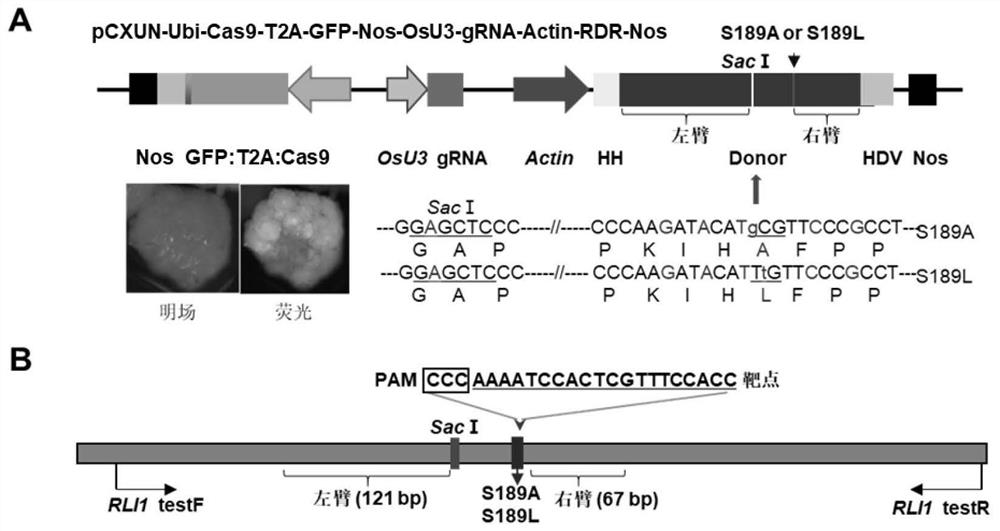Fluorescence labeled CRISPR/SpCas9 system mediated gene replacement system and application thereof in plants
A spcas9-t2a-gfp, fusion gene technology, applied in the field of target gene homologous recombination, can solve the problems of increasing off-target risk, heavy workload, easy pollution and the like
- Summary
- Abstract
- Description
- Claims
- Application Information
AI Technical Summary
Problems solved by technology
Method used
Image
Examples
Embodiment 1
[0057] Example 1. Construction of vector pCXUN-Ubi-NLS-SpCas9-T2A-GFP-Nos-OsU3-gRNA-Actin-RDR-S189A / S189L-Nos
[0058] In this example, a vector pCXUN-Ubi-NLS-SpCas9-T2A-GFP-Nos-OsU3-gRNA-Actin-RDR-S189A / S189L-Nos was constructed, which can realize the homologous recombination of the target gene (RLI1 gene) in rice. The specific method is as follows:
[0059] 1. Construction of expression vector
[0060] 1. Construction of plasmid pCXUN-Ubi-NLS-SpCas9-T2A-GFP-Nos
[0061] (1) The plasmid pCXUN-SpCas9 was double digested with restriction endonucleases StuI and AflII to obtain a vector backbone 1 of about 15350 bp.
[0062] (2) Using the chemically synthesized SEQ ID No.2 (that is, the T2A-GFP fragment with sequences homologous to the two ends of the backbone 1) as a template, a primer pair consisting of primer StuI-F and primer AflII-R was used for PCR amplification, the 5' and 3' end sequences of the PCR product are completely consistent with the two end sequences of the ve...
Embodiment 2
[0080] Example 2. Using CRISPR / SpCas9 system to realize homologous recombination of RLI1 gene (target gene) in rice
[0081] 1. Obtaining genetically modified rice
[0082] 1. Select the plump Zhonghua 11 rice seeds, peel off the seed coat, sterilize and wash, put them evenly in the sterilized NB solid medium containing 3.5mg / L2, 4-D, and cultivate in the dark at 28°C for 30-40d to induce callus production.
[0083] 2. After the callus obtained in step 1 was hyperosmotically treated in NB medium containing 0.3M mannitol and 0.3M sorbitol for 4-6h, the pCXUN-Ubi-NLS-SpCas9-T2A-GFP- The Nos-OsU3-gRNA-Actin-RDR-S189A / S189L-Nos plasmid bombarded rice callus by gene gun, using 0.6μm gold powder, bombardment pressure of 900psi for bombardment, after bombardment in NB containing 0.3M mannitol and 0.3M sorbitol After being cultured in the culture medium for 16 hours, they were transferred to N6 selection medium (NB solid medium containing 0.5 mg / L 2,4-D and 50 mg / L hygromycin), and ...
Embodiment 3
[0094] Embodiment 3 detects the separation situation of T1 seed offspring
[0095] Collect wild type Zhonghua 11 rice (ZH11), T prepared in Example 2 1 Generation transgenic plant (#2-1) and the T prepared in embodiment 2 1 The seeds of transgenic plants (#1-8) of the first generation, after the seeds germinated, the fluorescence was detected by a fluorescence microscope. The genomic DNA of the above seeds was extracted, and the genomic DNA was used as a template to carry out PCR amplification using a primer pair composed of primer RLI1 TestF and primer RLI1 TestR. The schematic diagram of PCR amplification is shown in figure 1 B in
[0096] Figure 5 for part T 1 Generation seed fluorescence observation results, where, BF: Bright-field: bright field, Flu: Fluorescence, fluorescence. Such as Figure 5 As shown, seeds harvested from T1 plants containing the GFP expression cassette were divided into two groups: one group showed strong green fluorescence and the other gro...
PUM
 Login to View More
Login to View More Abstract
Description
Claims
Application Information
 Login to View More
Login to View More - R&D
- Intellectual Property
- Life Sciences
- Materials
- Tech Scout
- Unparalleled Data Quality
- Higher Quality Content
- 60% Fewer Hallucinations
Browse by: Latest US Patents, China's latest patents, Technical Efficacy Thesaurus, Application Domain, Technology Topic, Popular Technical Reports.
© 2025 PatSnap. All rights reserved.Legal|Privacy policy|Modern Slavery Act Transparency Statement|Sitemap|About US| Contact US: help@patsnap.com



